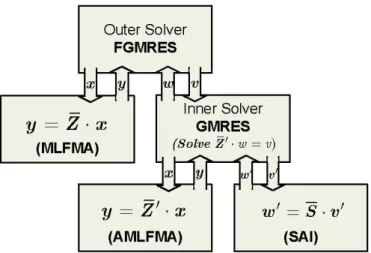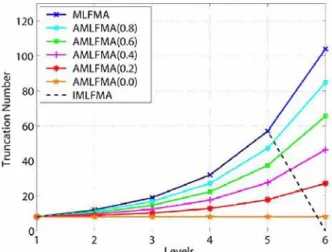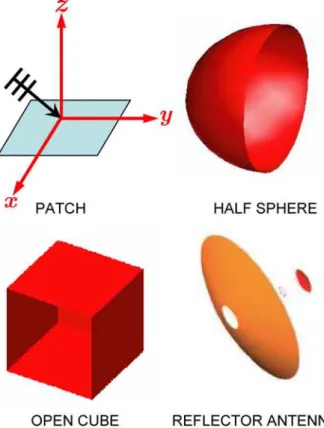THE
SOLUTION OF LARGE
EFIE
PROBLEMS VIA
PRECONDITIONED MULTILEVEL FAST
MULTIPOLE
ALGORITHM
T. Malas'2,
L.GiUrel,2
'Departmentof Electrical and Electronics Engineering 2Computational Electromagnetics Research Center (BiLCEM)
Bilkent University, TR-06800, Bilkent, Ankara, Turkey E-mail: tmalas@ee.bilkent.edu.tr,
lgurelgbilkent.edu.tr
fax: +90-312-2905755
Keywords: Preconditioning of the integral equation methods, electric-field integral equation, multilevel fast multipole algorithm, electromagnetic scattering.
Abstract
We propose an effective preconditioning scheme for the iterative solution of the systems formulated by the electric-field integral equation (EFIE). EFIE is notorious for producing difficult-to-solve systems. Especially, ifthetarget
is complex and the utilized frequency is high, it becomes a
challenge to solve these dense systems with even robust solvers such as full GMRES. For this purpose, we use an
inner-outer solver scheme anduse an approximate multilevel fastmultipole algorithm for the inner solvertoprovide avery
efficient approximation to the dense linear system matrix.
We explore approximation level and inner-solver accuracyto
optimize the efficiency of the inner-outer solution scheme.
We report the solution of large EFIE systems of several
targetstoshow the effectiveness of theproposed approach.
1
Introduction
In this paper we consider fast iterative solutions of the integral equation methods, which yield large and dense linear
systemsinthe form of
Z x =b. (1)
The solution of suchmatrix-equations mayhaveprohibitively large computational costs, unless fast methods, such as the multilevel fast multipole algorithm (MLFMA) [4], is employed for the matrix-vector multiplication that is required
atleastonce inaniterative method. If Ndenotes the number of unknowns, MLFMA performs the matrix-vector multiplication inO(NlogN) complexity. Hence,provided that the number of iterations does not grow rapidly as Ngrows,
integral-equation methods combined with MLFMA provide fast andaccurate solutions oflarge electromagnetic problems.
However, when the target geometry involves open surfaces, the only applicable formulation is the electric-field integral equation (EFIE), which produces ill-conditioned matrices that
aredifficulttosolveiteratively. Particularly, asthegeometry
size grows in terms of the wavelength, the system matrix becomes nearly singular and it becomes a challenge to solve these large linear systems in moderate memory and CPU
time. For this reason, there is strong need for developing parallel preconditioners that can be embedded in a parallel
MLFMAimplementation [6].
Ifthepreconditioner is constructed from the near-fieldmatrix, such as the sparse approximate inverse preconditioner [2], it lacks the information contained in the far-field interactions, which become dominant for large problems. Hence,
preconditioners relying ononly the near-field interactions are not sufficiently strong forEFIE problems. As a remedy, we propose an efficient approximation strategy to MLFMA,
which is used to build a preconditioner that carries enough information from the far-field interactions. Hence, the preconditioning operation is performedbyan iterative solver, which is nested in an outer iterative method used for the solution of (1). The performance of the approximate
MLFMA preconditioner is optimized by adjusting the
parametersof theMLFMAusedinthe inner iterations.
We show the effectiveness of the proposed approach by
solving a square patch with various sizes. Particularly, we
provide the solution ofa 256Ax256A problem that leadsto a
matrix-equation with 21,965,824 unknowns. This is the largestEFIEproblem reported, tothe best ofourknowledge. The problem is solved on 16 nodes of a cluster with Intel
Xeon 5355 processors. We show the accuracy of the solutions of patch problems by comparing them with the physical optics (PO) solutions. We also presentthe solution ofsomeothertargets includingareal-lifeproblem.
2
Approximate MLFMA Preconditioner
The usual practice in MLFMA is to keep the lowest level cluster-size fixed and partition the target in a bottom up
fashion [5]. Because ofthis, as the problem size and the
number of MLFMA levels increase, the near-field matrix becomes more and more sparse. Therefore, for large
problems, preconditioners generated from the near-field matrix cannot be strong enough for EFIE and we mayneed
morethan what is provided by the near-field matrix. We can
make the near-field matrix denser by increasing the size of the lowest-level clusters. However, this is very costly for
memory use,which is criticalinlarge-scale simulations. Also, themanipulation ofa denser near-field matrix(matrix-vector multiplicationorpreconditioner generation) canturnout tobe unaffordablein termsofCPUtime.
Onthe otherhand,wehave theopportunityto use aniterative method for preconditioning whenwe use a flexible solver to
solve the linear system (1) [9]. Hence, we canmake use of
MLFMA to have stronger preconditioners with respect to
those obtained from the near-field matrix. This approach produces anestedimplementation of iterative solvers [9]. In
the outer solver that solves the original system, we use
FGMRES,which is aflexible version ofGMRES. FGMRES
allows thepreconditionertochange from iterationtoiteration. Then, the preconditioner of this solver canbe anotherKrylov subspace solver which is called the inner solver. Weillustrate this preconditioning scheme in Figure 1. The inner solver makes use of an approximate MLFMA (AMLFMA) for efficiency and (possibly) a SAI preconditioner to accelerate itsconvergence.
Wecontrol the maximumerrorofMLFMAby thetruncation number
L 1.73ka+
2.16(do)2
(ka)1
3 (2)of the translation function, where a is the cluster size of the level anddo is the accurate number of digits [8]. We group
the relaxationstrategies ofMLFMAinto three:
1) By Reducing the Number of Accurate Digits. A less accuratebut cheaper version ofMLFMA can be constructed by reducing the number of accurate digits do as in [3].
However,the truncation number loosely dependsonthe value ofdo for large boxes in the higher levels ofMLFMA. For
example, foraneight-level problem, ifthe number ofaccurate
digits is reduced from four to one as in [3], the truncation number of the highest level decreases from 380 to 361, and thiscorrespondstoonly500 reduction. Hence, astheproblem size increases, this approach becomes less effective.
Moreover, new sets of arrays are needed for the radiation (receiving) patterns of the basis (testing) functions for the less-accurateMLFMA, and this adds asignificantcost tothe
memoryrequirement.
2) By Omitting Interactions atHigh Levels. Anotherway to
obtain a less-accurate MLFMA can be to interrupt the aggregationprocess at some level before reaching the topof the tree structure. Then, translation and disaggregation
processes are also ignored for highest levels. We call this versionincompleteMLFMA(IMLFMA). This approximation scheme requires neither extra computational load during the
setup nor significant modifications to the original MLFMA. Onthe otherhand, the processing time required for each level ofMLFMA is approximately same, hence, half of the levels should beignoredtoobtain5000 reductionintime. This leads
to a poor approximation of MLFMA since most of the interactions (usually much larger than the half of the interactions) are not computed. Therefore, IMLFMA usually failstoprovide the desired level ofaccuracywith significant gain from the computationaltime.
3)A MoreFlexibleStrategy (AMLFMA). Inorderto balance theaccuracyandefficiencyinaflexibleway,weredefine the truncation number for levelIas
(3)
Figure 1: Inner-outer solution scheme. Z' represents the linear operator whose matrix-vectormultiplication isprovided byAMLFMA.
There can be several ways ofachieving cheaper versions of
MLFMA. Now we discuss these possibilities and their
suitabilitytouse as apreconditioner.
where L1 is the truncation number defined for the first level,
LI
is the original truncation number for the level Icalculated by using (2). The approximation factoraf
is defined intherange from 0.0 to 1.0. As af increases from 0.0 to 1.0, the
AMLFMA becomesmore accuratebut less efficient, while it corresponds to the fullMLFMA when af =1. Hence, this parameter provides us important flexibility in designing the preconditioner. Moreover, the truncation number of the lowest level is not modified, hence AMLFMA does not
require extracomputation load for the radiation and receiving
2.1 Less Accurate MLFMA Schemes
patterns of the basis andtesting functions when it is used in
conjunction withMLFMAin anestedmanner.
We compare the change in truncation numbers and correspondingerrorsfor differentapproachesinFigures 3and 4. We note that computational time of the operations for a
level are proportional to L2 [5]. Therefore, we expect
significantgains for low approximation factors.
MLFMA 120 LIA AMLFMA(08) AMLFMA(0.6) 100 AMLFMA(0.4) AMLFMA(0.2) AMLFMA(0.0) E - - MLFMA/ 20 60 40 20 1 2 3 4 5 6 Levels
Figure 2: Truncation numbers of MLFMA attained with different approximation strategies. The geometry is a
20Ax20A patch with 137,792unknowns.
x104 AMLFMA(0.8) 153 0 1X104 AMLFMA(0.6) 10 o E a) <=-3 -2 -1 0<= Error Level qj) 4-Q) E a) w E X 4 IMLFMA(iI) 4... ... ... .... <=-3 -2 -1 0< Error Level
Figure 3: Error levels of various approximations of MLFMA with respecttooriginalMLFMA. IMLFMA(1)is obtainedby ignoringinteractions of thehighestlevel.
2.2 Issues for the Inner-Outer Solution Scheme
There are many factors that effect theperformance of
inner-outer schemes, such as approximation level of the
preconditioning operator to the linear system operator, the choice of the inner solver, inner stopping criteria, and
possibly a secondpreconditioner tobe usedto accelerate the
inner solver's convergence. Now we discuss these factors in moredetail:
1. Preconditioning operator. In fact, one can use the same linear system operator for the preconditioning operation by using the same MLFMA for both inner and outer solvers.
However, it is known that nesting strategyincreases the total number of matrix-vector products with respect to standard
Krylov methods [7]. On the other hand, sincewe only need
an approximate solution for preconditioning, a less-accurate
MLFMA may increase the efficiency. The discussion in the
previous section reveals that the AMLFMA is anappropriate choice. By adjusting the approximation factor
af
ofAMLFMA, both the accuracy and the computational time of the matrix-vector productcan be tunedto achieve maximum efficiency.
2. Inner solver and inner preconditioner. For the minimization of the overall cost, the preconditioner (i.e., the inner system and inner solver) shouldprovide a satisfactorily
accuratesolutionto anearby systemwithpossible least effort.
However, we observe that satisfaction level of the solution
canbe quite low, especially for small approximation factors.
Hence, for the iterative solver, GMRES seems agood choice, because it provides rapid residual-error decrease in early iterations, providing sufficiently accurate solutions in short times. Also, itcanbe beneficialtofurther accelerate the inner solver withafixedpreconditioner. Inthis context, SAIseems
agood candidate since it is successfulinreducing theerrorin
early iterations [3].
3. Innerstopping criteria. Relatedto the otherchoices, the relative residual errorand the maximum number of allowable iterations for the inner solver should becarefully selected. In
many instances, eventhe achievement of0.1 innererrormay
take many iterations, hence the maximum inner iteration number should be determined carefully to prevent unnecessarywork when the iterationsstagnate.
Combining the previous discussions, we conclude that SAI
preconditionedGMREStargeting 0.1 residualerrorandusing
AMLFMA with af =0.2 seems the most appropriate
choice. As shown in Figures 2 and 3, for an approximate matrix-vector multiplication with 0.2 incomplete factor, almost all elements of theoutputvectoriscomputed with less than 0.1 error (with respect to full MLFMA), while the computational time is significantly reduced. Hence, whenwe
fixthe targetresidual error to 0.1,
af
=0.2 seems the bestchoice. Lower residual errors necessitate a more accurate
matrix-vector multiplication, whosecomputation time cannot
be reducedsoeffectively.
3 Results
In this section we demonstrate the performance of the
AMLFMApreconditioner bycomparing it with SAI, which is commonly used in integral equation methods [3,1 1]. In
Figure 4, we show the open geometries that we use in our
-.1,
...:
F-1
numerical experiments, i.e., a patch, a half sphere, an open
cube with one missing face, and a reflector antenna. These
problems are solved for increasing frequencies, which require
denser meshes, larger number of unknowns and more MLFMA levels. We note that AMLFMA becomes more
efficient with increasing number of levels.
Inourexperiments we use the GMRES and FGMRES solvers
for their robustness. Wetry toreduce thenorm of the initial
residual by 10-6 in 1,000 iterations, unless stated otherwise. Weperform the paralleltests on a 16-node cluster connected via Infiniband network. The nodes have dual Xeon 5355 processorsand 16 GB of RAM.
the specular reflection (b=45, q= 180) and for forward
scattering (b =135, q =180). Hence, the accuracy of the MLFMA solution is verified with a perfect agreement
between thetwomethodsatthese points.
Next we present the solutions of the half sphere and open
cube geometries. For both of the problems, there is a very
significant decrease in the solution time with AMLFMA preconditioner. The largest problems, cannot be solved with SAI. Onthe other hand, inreasonable durations the largest
problems can be solved with AMLFMA.
Table 1: Number of iterations and solution times for the patch geometry. The dash ("-") denotes that solutioncannot
be achieved dueto memorylimitations. Thelargest problem is solved with10-3 iterative residualaccuracy.
HALFSPHERE 256 Xx256 X Patch
. . . . 1~~~~I 15 10 a] U) 0 REFLECTOR ANTENNA Figure 4: The targets that are used in the numerical
experiments. For the half-sphere and the open cube, the
illumination is from top. Forthe reflector antenna, a dipole sourceis used.
In Table 1 we present the solutions of the patch geometry.
For SAI we use the near-field matrix pattern for the
approximate inverse. For AMLFMA, we use af=0.2 for and
a stoppingtolerance of 0.1 or amaximum of10 iterations for
the inner solver. The results in Table 1 indicate that as the
problem size increase, the AMLFMA preconditioner becomes
more effectivecomparedto SAI. The solution time is halved
for large problems. Furthermore, with AMLFMA, we are
able to solve an approximately 22-million-unknown problem
thatcorresponds toa 256Ax256Apatch. Since this is avery
large problem in terms ofA, we compare the MLFMA
solution with thePO solution inFigure 5. The incomingfield
isay-oriented planewave onthexz-plane and makes 450 with
thez. We expect PO solution to beparticularly accurate for
u /u 4U uu ou 'Iuu 'I u 'I4U 'Iuu 'Iou
Figure 5: Bistatic RCS with PO and MLFMA for the largest patchgeometryhaving 21,965,824 unknowns.
Finally in Table 4, the results for the reflector antenna are
demonstrated. Even though the solution of the smaller problem is achievable with both SAI and AMLFMA, the largest problem again, can only be solved with AMLFMA.
Hence, the successofAMLFMA is also shown on areal-life
problem.
4 Conclusion
In this work,we take advantage of the MLFMA structure to
generate a very effective preconditioner. We solve a nearby
system approximately but quickly with AMLFMA, and SAI AMLFMA
r Tim Outer
[
IInnr
TimeIW
_ 11X W __111 ll% PATCH i i- i* MLFMA PO OPEN CUBE 0 0 i iembed the solution in the main iterative solution. The approximation level of the proposedAMLFMA canbe tuned withaparameter, enabling optimization of the globalcostof
AM LFMA nnerl
208
700_
440 2
I
Table 2: Number of iterations and solution times for the half sphere geometry. The largest problem is solved with 10-3 accuracy.
h
AMLFMAnner| 517
_1,607_
I
Table 3: Number of iterations and solution times for the open
cubegeometry.
F
SAI_
__6
_D_
_AMLFMA
128_ X 32, eI
Table 4: Number of iterations and solution times for the reflectorantenna.
References
[1] S. Balay, W. D. Gropp, L. C. McInnes, and B. F. Smith, "PETSc users manual," Argonne National Laboratory, Tech. Rep.ANL-95/11-Revision 2.1.5, 2004.
[2] M. Benzi, "Preconditioning techniques for large linear systems: a survey," J. Comput. Phys., vol. 182, no. 2, pp.
418-477,2002.
[3] B. Carpentieri, I. S. Duff, L. Giraud, and G. Sylvand, "Combining fast multipole techniques and an approximate inverse preconditioner for large electromagnetism calculations," SIAMJ. Sci. Comput., vol. 27, no. 3, pp. 774-792, 2005.
[4] W. C. Chew, J.-M. Jin, E. Michielssen, andJ. Song, Eds.,
Fast and
Efficient
Algorithms in ComputationalElectromagnetics. Norwood, MA, USA: Artech House, Inc., 2001.
[5] 0. Erguil, "Fast multipole method for the solution of electromagnetic scattering problems,"Master'sthesis, Bilkent University, Ankara, Turkey,2003.
[6] 0 . Erguil and L. Guirel, "Efficient parallelization of multilevel fast multipole algorithm," in Proc. European
Conference on Antennas and Propagation (EuCAP), no.
350094, 2006.
the solver for maximumperformance. Wepropose astrategy
to adjust the approximation level and the inner-solve
accuracy, which produces outstanding performance in open
geometry problems that has to be modeled with EFIE. Our strategy renders many difficult systems solvable, and for
thoseconvergingwithSAI, thespeedupismorethantwofor
thepatch and halfsphere geometries. Hence, we have been
able solve several problems with millions of unknowns in
modest iterationcountsand solution times.
Acknowledgements
This work was supported by the Scientific and Technical
Research Council of Turkey (TUBITAK) under Research
Grant 105E172, by the Turkish Academy of Sciences in the framework of the Young Scientist Award Program (LG/TUBA-GEBIP/2002-1-12), and by contracts from ASELSAN and SSM. Computertimewasprovidedin partby agenerousallocation from IntelCorporation.
[7] J.vandenEshof,G. L. G.Sleijpen, andM. B.vanGijzen, "Relaxation strategies for nested Krylov methods," J. Comput.Appl. Math., vol. 177,no.2,pp. 347-365, 2005.
[8] M. L. Hastriter, S. Ohnuki, and W. C. Chew, "Error
control of the translation operator in 3D MLFMA,"
Microwave Opt. Technol. Lett., vol. 37, no. 3, pp. 184-188, 2003.
[9] J. Lee, J. Zhang, and C.-C. Lu, "Sparse inverse preconditioning of multilevel fast multipole algorithm for hybrid integral equations in electromagnetics," IEEE Trans. AntennasandPropagation,vol.52, no. 9, pp. 158-175, 2004.
[10] Y. Saad, Iterative Methodsfor Sparse Linear Systems,
2nd ed.Philadelphia,USA:SIAM, 2003.
[11] V. Simoncini and D. B. Szyld, "Flexible inner-outer Krylov subspace methods," SIAMJ. Numer. Anal., vol. 40,
no.6, pp. 2219-2239, 2002. I I I Timez Time Outer. 128 21 N Iter 116,596 15( I - I - I - I . .~~~~~~~~~~~~~~~~~~~~~~~~~ Time 57 361 Time Outer 58 34 445 52 161 N Iter 65,696 2( 263,032 4( I - -I .I I - - -SAI 6 7 1 0 SAI r 05 04



